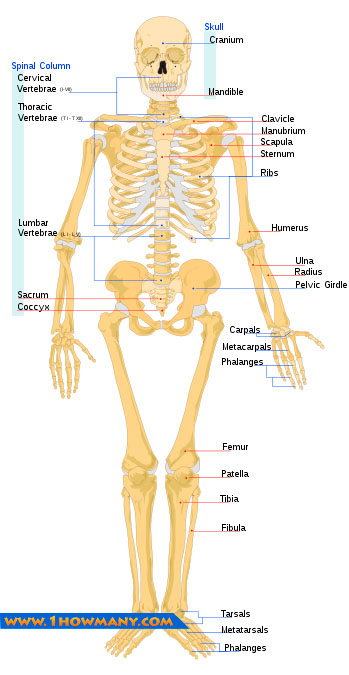www.1howmany.com
Example How Many Bones in the Human Body
Health / How Many Bones in the Human Body
How Many Bones in the Human Body
Bones make up the “structural frame” for the human skeleton. If we had no bones, we would not be able to move, our internals would have poor protection, and they would lack blood and calcium. As you can guess, we have many bones, but do you know their exact number.
There can be two different answers to the question about how many bones are in the body, depending on whether we mean babies or adult humans.
- A newborn baby’s skeleton consists of approximately 300 - 350 bones
- An adult human body consists of 206 bones
Now, if somebody asks you, “How many bones are in a human body?” you can give the correct answer:
The number of bones changes because in the process of growing some of them fuse together during first years of life. The most illustrative example of this phenomenon is the human skull. In fact, formation of bones never ends. They are constantly renewed throughout life. Several types of cells take part in this remodeling:
- Osteocytes maintain bones
- Osteoclasts destroy bones
- Osteoblasts form new bones
Scientists divide all the bones into four groups: short bones, long bones, irregular bones, and flat bones. They are also distributed in two different systems: the axial skeleton and the appendicular skeleton. The stapes3 is the shortest bone (about one tenth of an inch), and the femur4 is the longest one.
Names of bones
Number of Bones
The Axial Skeleton
Cranial Bones
8
Facial Bones
14
Ossicles
6
Hyoid bone
1
Vertebral column (cervical, thoracic, lumbar, sacrum, and coccyx)
26
Bones of the thorax (sternum and ribs)
25
The Appendicular Skeleton
Shoulder girdles (clavicles and scapulae)
4
Upper limbs: arms (humerus), forearms (clavicles and scapulae), and hands (carpus, digits, and metacarpus)
60
Hip girdle
2
Lower limbs: (femur, patella, tibia, fibula, tarsus, digits, and metatarsus)
60
Total: 206 bones
All the bones support and maintain our body making the adult human skeleton. You should also remember that some people have extra ribs or lumbar vertebra, though not everyone has sutural bones.
Some Facts about Human Skeletons
Here are some interesting facts about human skeletons:
- The femur, which is the longest bone in the body, equals about one fourth of the man’s height.
- Necks of giraffes and humans consist of the same quantity of bones.
- Hands and feet have most of the skeleton bones.

- The skeletal system means the system of different bones, cartilages and joints of the body. All these structures make up the skeleton
- The bone marrow is a pliant tissue which can be found inside of bones. It is very important for human bodies because it produced blood cells and lymphocytes. It also prevents the backflow of the lymph. The bone marrow composes about four percent of the human body mass.
- The stapes (also called stirrup because of its shape) is the smallest bone in the human body. It is situated in the middle ear. The stapes transmits vibrations to the inner ear.
- The femur is the longest bone in the human body. It is articulated at the knee and the hip.
You may be interested in:
Comments
